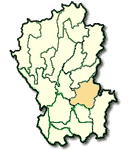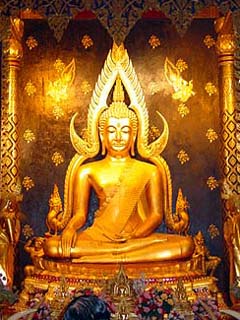Phitsanulok Province in Northern Thailand

Phitsanulok is 377 kilometers. north of Bangkok. It is one of the most interesting northern provinces and is an important commercial, transportation and communications centre. Phitsanulok is situated on the geographical and administrative line uniting the Central and Northern regions.
Phitsanulok was the birthplace of King Naresuan the Great of Ayutthaya and his equally brave brother Prince Ekathosarot. It has long been an important centre for political and strategic reasons. Phitsanulok was a major place of recruitment when Ayutthaya waged war with Burma and a training ground for many Ayutthaya kings. During the reign of King Boromtrailoknart of Ayutthaya, it was also a capital of Thailand for 25 years .
Phitsanulok's climate is generally hot and humid. It borders Uttradit to the North, Pichit to the South, Loei and Phetchabun to the East and Kamphaeng Phet and Sukhothai to the West. Phitsanulok province(Changwat) covers some 10,815 square kilometres.
What to see and what to do in Phitsanulok?
Wat Phrasi Ratana Mahathat is a major city landmark and houses Thailand's most beautiful and significant Buddha image, Phra Buddha Chinnarat. The image was cast in 1357 during the reign of King Mahatammaracha of Sukhothai. The beautiful mother-of-pearl inlaid doors were built in 1756 by King Boromakot of Ayutthaya. The Buddha Chinnarat National Museum in the temple compound houses a collection of Sukhothai art.

Phra Buddha Chinnarat, Phitsanulok
Wat Chulamani
The temple's corncob-shaped tower or Prang is well known among students of archaeology and history. The temple is Phitsanulok's oldest historical site. In a highly individual style and pattern, it boasts extremely interesting, ornate and elaborate plaster designs found nowhere else in Thailand.
Shrine of King Naresuan the Great is located in the compound of the Phitsanulok Phittayakom school. The seated figure of King Naresuan the Great pours lustral water from a golden container while ceremoniously declareing Ayutthaya's independence from Burma. The shrine was built in 1961 on the site of the Chandra Palace where King Naresuan was born in 1555.
Sergeant-Major Dr.Thawee BuranaKhet Folklore Museum. Opposite the Buranathai Buddha Image Factory on Wisutkasat Road, this museum is well known for its collection of folk arts, crafts, basketry, pottery and ancient kitchen utensils. There are also many agricultural and household instruments displayed.
Houseboats along the Nan River
Phitsanulok has another name, Song Kwae. Song Kware means the town of two rivers. The 127 kilometre Nan River is Phitsanulok province's most important waterway. The Kwae Noi River also flows from the north and joins the Nan River near Phitsanulok's down town area. The junction divides Phitsanulok into the East and West Banks. People gather on houseboats and raft houses along both sides of this major transportation route and adhere to a traditional waterborne ways of life.
Rice Farming Roads surrounding Phitsanulok provincial capital permit views (in June) of ricefields where blue shirted farmers wearing straw hats are useing water buffaloes to plough the rich black soil to cultivate Thailand's staple.
OUT-OF-CITY ATTRACTIONS ( Phitsanulok-Lomsak Road/Highway No.12)
Sakunothayan Botanical Garden is situated at Kilometre 33, where a right turn leads to a 500 meter access road. H.M. the King graciously bestowed the park name during a tour of the North in 1958. The picturesque Wang Nok Aen Waterfall, some 10 metres high, cascades among rocks to create a beautiful site.
Kaeng Song Waterfall is situated beside the road at Kilometre 44.
Poi Waterfall
A sign at Kilometre 61 Suan Pa Khao Krayang road introduces a 2 kilometre access road to Poi Waterfall. Before reaching the cascade, one sees many species of flowering trees. Poi Waterfall is distinguished by copious flow and profuse rocky outcroppings.
Kaeng Sopha Waterfall
A laterite road at kilometre 70 branches off through the forest some 2 kilometres beyond the Thung Salaeng Luang National Park office to reach this waterfall. It is regarded as being the largest in the region.
Thung Salaeng Luang National Park is comprised of one of Thailand's major large forest areas and spreads across some 789,000 rais in Phitsanulok and Phetchabun. The park office is located at kilometre 80 on the Phitsanulok-Lomsak Highway, a picturesque road that passes through lush green forests and high mountains.
Phu Hin Rong Kla National Park spreads across areas of Phitsanulok, Phetchabun and Loei. It was formerly a battleground between Thai government forces and communist insurgents. Hostilities have long since ceased and the rugged area has been transformed into a national park of arresting scenic beauty. To reach the park from Phitsanulok, tourists should drive along the Phitsanulok-Lomsak Highway and turn left at Kilometre 68 onto the Phitsanulok-Nakhon Thai Road. After traveling some 24 kilometres, a right turn must be made at Ban Nong Krathao, some 28 kilometres beyond which the park office will be seen.
Park attractions include Lan Hin Taek, natural rock formations covered with orchids, ferns, moss, lichens and seasonal flowers and former communist buildings and encampments The latter are by far the more interesting.
Chat Trakan National Park covers 146,875 rais and a seven levelled waterfall is the source of the Kwae Noi river. The park is reached via the Phitsanulok-Lomsak Highway to kilometre 68, turn left, continuing for 38 kilometres to Amphoe Chat Trakan, a total distance of 135 kilometres.
Walking tour of Phitsanulok
Begin the tour at Wat Phra Si Rattana Mahathat locally called Wat Yai , the major city landmark erected in 1357. The main chapel houses the magnificent golden Buddha image called Phra Buddha Chinnarat. The image is the most beautiful and significant one in Thailand. After savoring its beauty, do not miss the mother-of-pearl inlaid chapel doors built in 1756. Then circle the chapel clockwise to visit the Phra Buddha Chinnarat National Museum to inspect a number of Sukhothai and Ayutthaya period artifacts.
(please note: Take off your shoes before entering the chapel. Short pants, sweatshirts or any kind of revealing attire are inappropriate inside the temple.)
Upon leaving the temple, Wat Nang Phya and Wat Ratburana are on the left side of the road. The chedis or pagodas and chapels of the two temples are over 400 years old.
After visiting the three temples, you may walk along the Nan River footpath. This river is one of Thailand's four major northern waterways which merge at Nakhon Sawan, 129 kilometres south of Phitsanulok, and form the Chao Phraya River which flows southwards to the sea through Bangkok.
You may see many houseboats on the Nan River. Phitsanulok is the only place in Thailand where houseboats are legal for they existed long before municipal law. On the river bank you will see the beautiful River park where you can visit the Riverside Bazaar.
There you can enjoy the bustle of a typical Thai market. Some stalls sell Buddha amulets in hundreds of shapes and sizes. Other sights include utensil shops. Turn left at Sai Lue Thai Road to the City Clock Tower . Proceed straight and turn left to Ekathosarot Road to the Phitsanulok Railway Station where a monument for an ancient steam locomotive is the focal point.
Beyond the Railway station, on Ekathosarot Road is the Municipal Market where several kinds of inexpensive and delicious foods, tropical fruits and Thai desserts are available. This is the end of your walking tour.
Note : The Riverside Bazaar becomes a food bazaar where foodstalls serving Thai and Chinese food and desserts operate from 06:00 PM until 03:00 AM.
Samlor Tour
This tour is specially designed for visitors to enjoy Phitsanulok's night time ambience. The three wheeled samlor ride beside the riverside food bazaar where chefs deep fry morning glory vegetables and toss them some distance onto plates is a very enjoyable experience.
The Phra Buddha Chinnarat Fair occurs at Wat Phra Si Rattana Mahathat. The fair includes folk performances and various local entertainment. It is staged on the sixth day of the waxing moon of the third lunar month (usually late February) and lasts for six days.
Long-Boat Races are customarily held on the Nan River in front of Wat Phra Si Rattana Mahathat during the first weekend of October.
